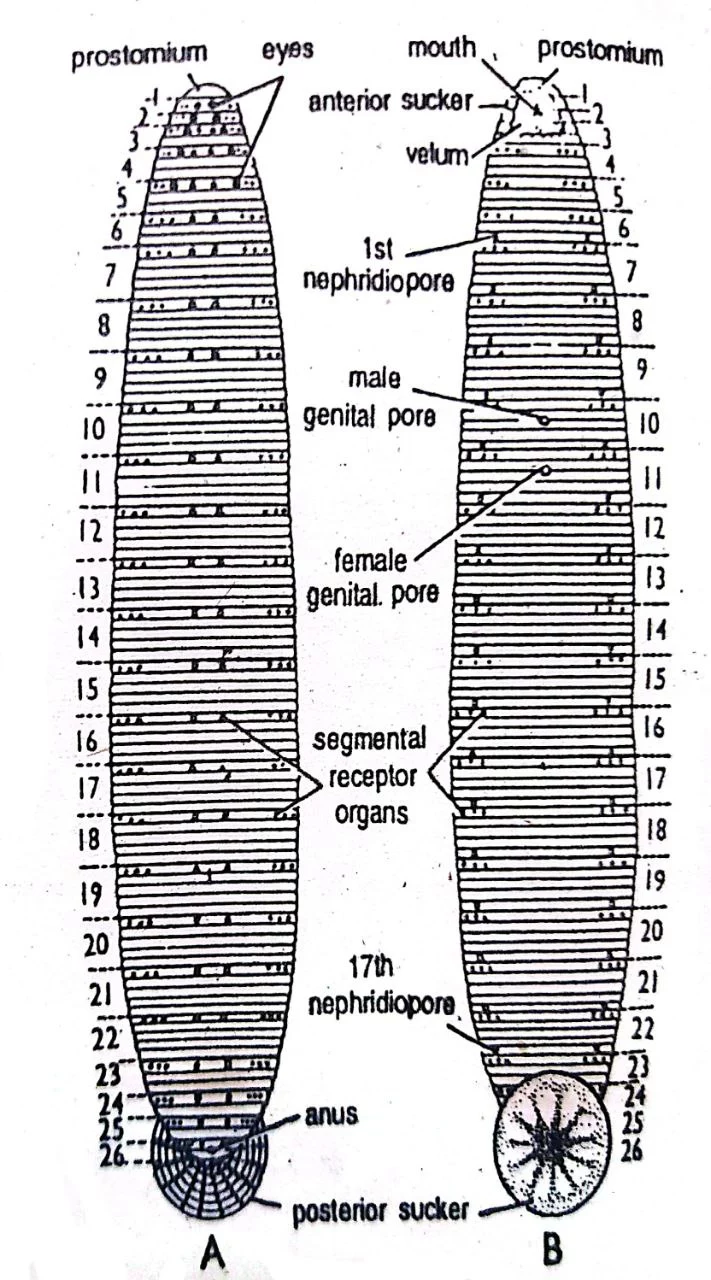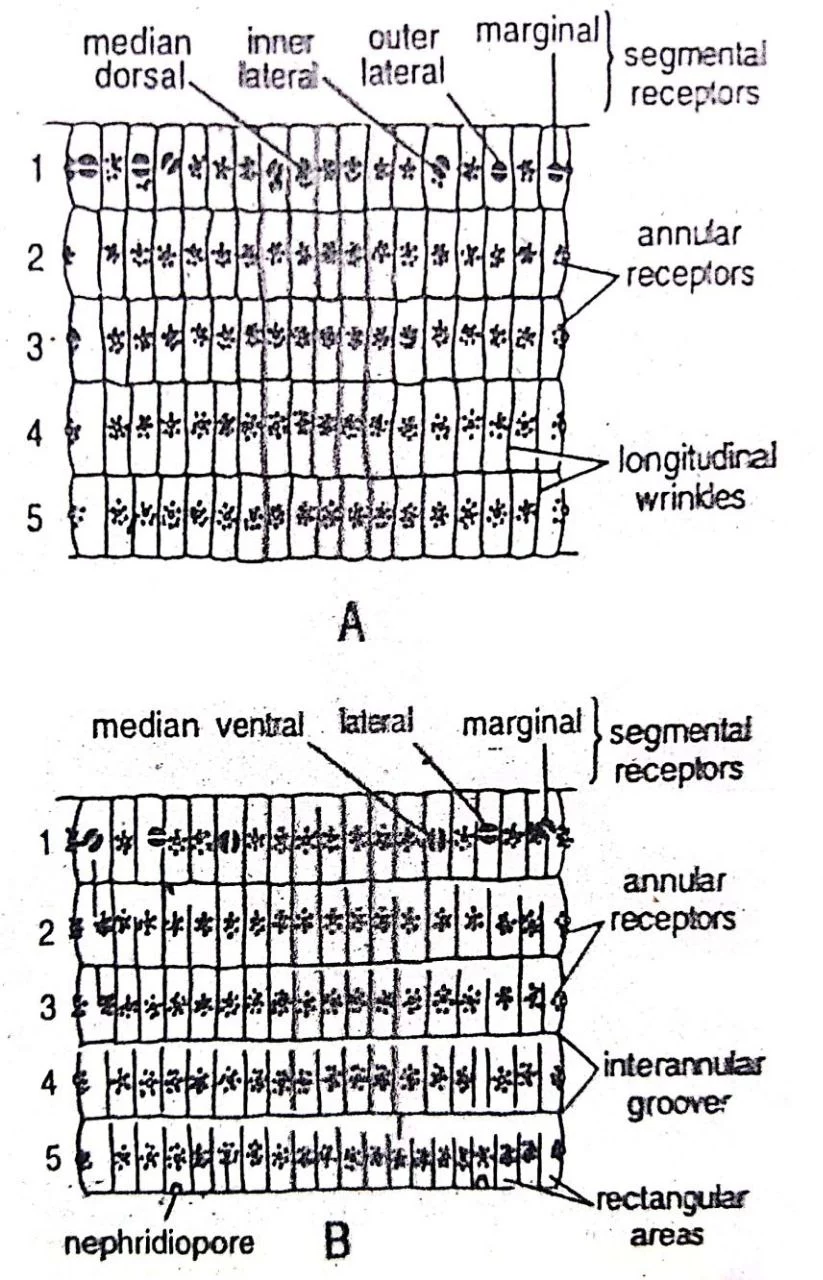Hirudinaria granulosa, also known as the Indian cattle leech, is a species of leech that is found in freshwater habitats in Bangladesh, India, Pakistan, Myanmar, and Sri Lanka. In this article, we will learn about the external morphology of Hirudinaria granulosa. It is a large leech, typically measuring 10-15 cm in length. The body of this leech is soft, vermiform, and dorsoventrally flattened. The term external morphology of Hirudinaria, the external structure of Hirudinaria, or the external features of Hirudinaria are similar.
Labeled Diagram of Hirudinaria granulosa or Leech

External Morphology of Hirudinaria granulosa
The external morphology or the external structure or the external features of Hirudinaria is given below:-
Shape and Size
- It is a soft, vermiform, and elongated structured body.
- The leech is dorso-ventrally flattened.
- The body is 10-15 cm long.
- A full-grown leech may measure up to 35 cm long.
- The body of the leech is narrow at the anterior end and broad at the posterior end.
- It is capable of great expansion and contraction.
- The body is ribbon-shaped when expanded and cylindrical when contracted.
- In a normal leech, the dorsal surface of the body is convex and the ventral surface of the body is quite flat.
- The body is oval-shaped in a transverse section.
Coloration
- The dorsal surface of the body is olive-green in color.
- The ventral surface of the body is orange-red or orange-yellow in color.
- The sides are orange or yellow colored.
- The ventral stripes are black.
- The dorsal spots are also black in color.
Segmentation

- The body of the leech is divided into 33 segments.
- The segments are also called somites and they are metamerically divided.
- Except for the first two and last seven segments, the other segments are again subdivided into rings or annuli.
- A typical segment has five annuli.
- Incomplete segments have less than five annuli.
- During the breeding season, a temporary clitellum is formed.
- The clitellum is formed in the 9th, 10th, and 11th segments.
Receptors
- The surface of each annulus is divided by fine longitudinal furrows into rectangular areas.
- Each area bears an annular receptor.
- The annular receptor is a minute and elevated sensory papilla.
- Each annulus bears a total of 18 annular receptors on the dorsal and 18 annular receptors on the ventral side.
- There are other large sensory papillae present called segmental receptors or sensillae.
- The first annulus of each segment bears 4 pairs of segmental receptors on the dorsal and 3 pairs of segmental receptors on the ventral side.
- The first annulus of each of the first five segments bears a pair of eyes.
Suckers
The leech bears two suckers. One is present at the anterior end of the body and the other is present at the posterior end of the body. The suckers help the leech in adhesion and locomotion. The anterior sucker helps in feeding.
Anterior Sucker
- It is also called the cephalic sucker.
- It comprises the prostomium and three anterior body segments.
- It is oval in shape.
- The mouth is located at the bottom of the anterior sucker.
Posterior Sucker
- It is located at the posterior end of the body.
- It is circular in shape and highly muscular.
- It is also called the anal sucker.
- It is formed by the fusion of the last seven segments.
External Apertures
- The mouth is present at the center of the anterior sucker.
- The anus is located at the mid-dorsal position of the 26th segment.
- There are 17 pairs of nephridiopores present on the last annulus of each of the 6th-22th segments.
- The male genital pore is present in the 10th segment.
- The female genital pore is present in the 11th segment.
Body Divisions
The body of the Hirudinaria leech is divided into six regions. They are given below-
Cephalic
- It is composed of the first five segments.
- These segments are called ocular segments.
- This body part contains the prostomium, anterior sucker, mouth, and eyes.
- Nephridiopores are lacking in this body part.
Pre-clittelar
- It is composed of the 6th, 7th, and 8th segments.
- This body part bears nephridiopores.
Clitellar
- It is composed of the 9th, 10th, and 11th segments of the body.
- It possesses highly glandular walls.
- This body part bears nephridiopores.
- A permanent clitellum does not present in Hirudinaria.
- The clitellum is developed during the breeding season.
Middle
- It is composed of the 12th to 22nd segments of the body.
- It is the largest part of the body.
- This body part bears nephridiopores.
Caudal
- It is composed of the 23rd to 26th segments of the body.
- These four segments are incomplete segments.
Posterior Sucker
- It is composed of the last seven segments of the body.
- It is arranged in concentric rings.
——–THE END———
Read More:
- The Digestive System of Hirudinaria | Leech | Diagram
- General Characters of All Phylum of The Invertebrates.

Md Ekram Hossain Bhuiyan is a passionate student currently pursuing his studies at Jagannath University in Dhaka. He is a zoology major and his love for animals, nature, and wildlife is evident in his academic pursuits. Ekram is a curious and adventurous individual who always seeks to learn more about the world around him. His passion for animals began at a young age, and he has since dedicated himself to studying the behavior, anatomy, and habitats of various species.
He finds peace in being surrounded by the beauty of nature and observing the creatures that call it home. He believes that it is important to protect and preserve the natural world for future generations.
As a student of zoology, Ekram is dedicated to expanding his knowledge of the subject. He is a hardworking individual who strives for excellence in his studies and is always eager to take on new challenges. Ekram is a driven and compassionate individual who is dedicated to his studies and his passion for animals, nature, and wildlife.